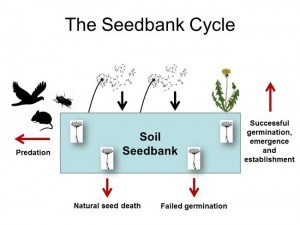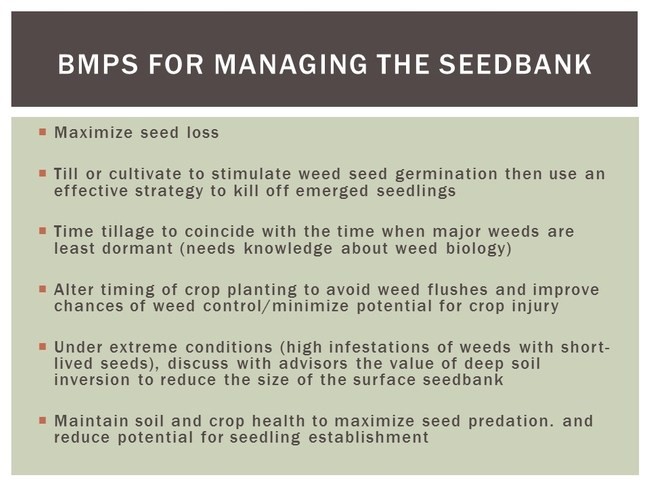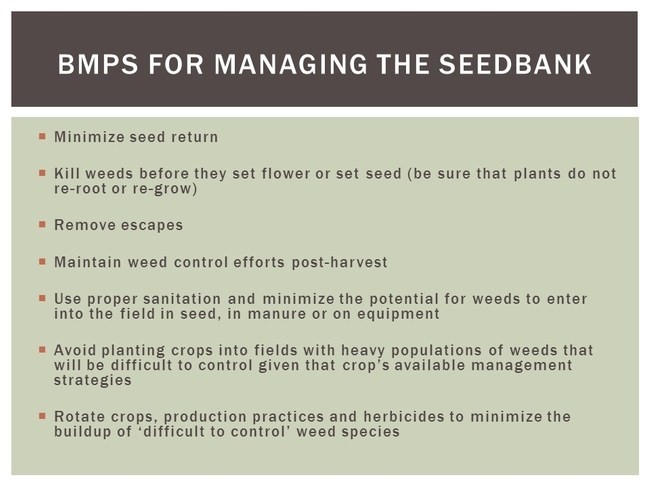Written by Lynn Sosnoskie, WSU Weed Science. May 5, 2017.
When researchers think about weed control in crop production, we often think about ‘short-term’ results, i.e. weed control after 30 days, weed control after 90 days, weed control at harvest, etc. But weeds and weed control efforts in one cropping season can significantly influence the density and composition of weeds in following years. The carryover between seasons is accomplished via the weed seedbank and weed control successes and failures are reflected by changes that occur in this reservoir (Figure 1). In good years, weeds are successfully controlled and few to no seeds may enter the seedbank. In bad years, when weeds escape management strategies, rogue plants may flower, set seed, and contribute to this genetic stockpile.

Why is the seedbank important with respect to weed control?
Numerous studies have demonstrated that as weed seed numbers increase, so do the numbers of weeds that survive management strategies (Diehlman et al. 1999; Hartzler and Roth 1993; Sparks et al. 2003; Taylor and Hartzler 2000). In other words, the greater the number of seeds in the seedbank, the greater the number of weeds that may emerge, and the greater the number of plants that may escape chemical or cultural control practices. Weed escapes necessitate that growers engage in additional management practices that may have been unplanned and that add to the cost of crop production. Increased seedbank/in-crop weed densities could also facilitate the development of herbicide resistance. According to Jasieniuk et al. (1996), where weed infestations are heavy, the probability of selecting for resistance can also be high, even if the mutation rate (that leads to the development of resistance) is low.
How do you manage the seedbank?
So, how do we specifically target the seedbank for weed control?
- Increase seed mortality. For example: seeds are not impervious to decay and damage; pathogens can colonize seeds in the soil whereas birds, small rodents and insects will feed upon them. Studies have shown that farm-level management practices (e.g. tillage, cover cropping, pesticide use) can affect weed seed predation (Menalled et al. 2006), although landscape level factors (e.g.habitat diversity, predator diversity) ultimately influence in-crop seed survival, as well (Trichard et al. 2013). Think about conserving weed seed predators like ground beetles.
- Don’t let seed return to the soil. Your grandmother was spot on: ‘One year of seeding means many years of weeding’. Prevention can assume many forms: handweeding, cleaning equipment between production sites, mowing weeds prior before flowering, and screening irrigation water to prevent seed immigration. Prevention should be during the whole season, not just during the cropping season.
In short, if you really want to reduce the seedbank, you’ll need to attack it on multiple fronts: i.e. maximizing seed loss (Figure 2) and minimizing seed return (Figure 3).


Weeds will always find a way into your orchard (for instance, you can’t stop the wind from blowing), but you can maximize the impact that the seedbank has on your (current and future) level(s) of weed control. The ultimate goal of weed control is to protect this year’s yields AND to try and reduce pest densities in coming seasons.
References
Diehlman et al. 1999. Weed Science. 47:81-89.
Hartzler and Roth. 1993. Weed Technology. 7:611-614.
Jasieniuk et al. 1996. Weed Science. 46:176-193.
Menalled et al. 2006. Handbook of Sustainable Weed management. The Haworth Press, Inc.
Taylor and Hartzler. 2000. Weed technology. 14:261-267.
Trichard et al. 2013. Basic and Applied Ecology. 14:235-245.
Contact
 Lynn M. Sosnoskie, Ph.D.
Lynn M. Sosnoskie, Ph.D.
Assistant Research Faculty, Washington State University
Tree Fruit Research and Education Center
Wenatchee, WA 98801
@LynnSosnoskie on Twitter
Phone: 229-326-2676
